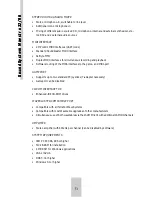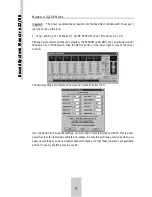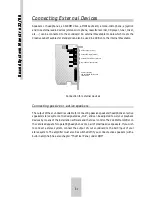
55
SoundSSoundSSoundSSoundSSoundS
yyyyy
sssss
tem Maestem Maestem Maestem Maestem Maes
tro32/96tro32/96tro32/96tro32/96tro32/96
does not need any driver under DOS, as it is merely initialised during the start process. When
the necessary files have been copied to your hard disk, the system opens a window in which
you are able to enter the settings of the resources. The software can be installed on the same
way.
The preset values in the installation program should function in most common computer
configurations. In the event of any conflicts, you can change the values by using the program.
However, first try to change the resources of other expansion cards such as VGA, video or
MPEG cards, as most DOS games use the preset default values of the soundcard. You should
also deactivate the interrupts of the unused slots in the BIOS of your mainboard. The relevant
procedure is detailed in the manual of your mainboards.
If your soundcard package includes the TerraTec Driver CD-ROM as opposed to floppy
discs, please follow the instructions on the Quick Reference Guide.
IRQ, DMA and I/O Addresses, what does it all mean?
If you make any changes to your hardware (if you for instance install another card), if any
problems occur during the installation procedure or if you simply want to know more about
this question, we will now explain these concepts briefly.
Computers operate with signal lines or channels, and system components communicate with
the central processor (CPU) or the memory on the mainboard via these lines or channels. If two
components try to use the same communication line simultaneously, there is a conflict. There
are three types of signal lines available for exchanging information and data.
1. IRQ or interrupt lines are required if a component notifies the central processor that data
are to be output or received.
2. DMA channels (Direct Memory Access) are responsible for transmitting data to main memory
(in contrast with the process of transmitting data to the processor).
3. I/O or input/output addresses are special address ranges provided for the data exchange
process between the system components and the central processor.
These resources are set by a PnP BIOS without any conflict. However, changes can be made
under Windows 95. In the device manager within the system control under settings, you will
find a page designated „resources“ which displays the distribution of the signal lines. If the
button „set automatic“ is disabled, you can use a different distribution for the resources, and
the operating system always tells you if there is a conflict.
Under DOS/Windows 3.x without PnP BIOS, you must ensure yourself that no conflicts occur in
your computer. For this purpose, you must know what resources have already been allocated.
Please consult the manuals of your motherboard and any additional cards to identify the standard
settings. You should also release PCI slots which are not being used.
Summary of Contents for Maestro 3296
Page 1: ...SoundSystem Maestro3296 Handbuch Manual...
Page 80: ......
















































